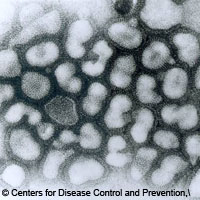Deadly aspect of H5N1 identified
Researchers from the UK, Vietnam and China have discovered why the H5N1 strain of flu is so deadly - because it over-stimulates the body's immune responses. The results, published in the journal Nature Medicine, followed patients suffering from H5N1 and compared them to subjects suffering far less serious forms of flu. Currently the mortality rate for humans who contract H5N1 stands at about 58 per cent - a statistic that alarms many working in public heath and safety. The study, led by Dr Menno de Jong of the Oxford University Clinical Research Unit in Ho Chi Minh City, monitored 18 Vietnamese subjects who had contracted H5N1 in 2004 and 2005. A total of 13 of those subjects later died. Taking nose and throat swabs, the researchers found that the virus replication level was hundreds of times greater than in conventional flu strains, and that the virus preferred to reside in the respiratory tract, rather than the usual nose and throat. The research has already been described as 'landmark' by Peter Openshaw from London's Imperial College, quoted in Nature Medicine. The team found that the infection is so fast-moving and powerful that it triggers a 'cytokine storm'. Cytokine is the signal molecule used to alert white blood cells to an infection. Sometimes the body can massively over-produce cytokine, producing an over-production of white blood cells, with often-fatal results as the body effectively attacks itself. A cytokine storm is implicated in deaths from SARS, and in the near-death experiences of the UK guinea-pigs who volunteered to test the cancer drug TGN1412. Two possible reasons for the cytokine storm in this case could be that the virus itself produces cytokine, so encouraging more immune response, or that the virus replicates so quickly, the body goes into overdrive, producing more and more white blood cells to try and keep up. Lead researcher Dr de Jong has made an important breakthrough in the understanding of H5N1, and this may now shift treatments from anti-replication drugs such as Tamiflu to medicines designed for use in arthritis, such as steroids or temporarily disabling T-cell responses using drugs designed to treat lung inflammation. 'Our observations indicate that high viral load, and the resulting intense inflammatory responses, are central to influenza H5N1 pathogenesis. The focus of clinical management should be on preventing this intense cytokine response, by early diagnosis and effective antiviral treatment', reads the paper. Despite this breakthrough, Dr de Jong seems somewhat disappointed that more data could not have been taken, for example to look at genetic make-up, to see if there could be a susceptibility in some people to H5N1. 'It's too bad we haven't learned more,' Dr de Jong said in an interview with Nature. 'If samples had been collected from all those patients, we would be a lot further in understanding this disease.' These findings agree with some preliminary research from Belgian virologist Professor Marc Van Ranst, who spoke to CORDIS News in April. Prof Van Ranst compared the windpipes of recently deceased birds with the symptoms of the dead during the H1N1 'Spanish flu' outbreak of 1918. Both the birds and soldiers had bloody 'spots' on their windpipes, indicating a very strong immune response.
Countries
China, United Kingdom, Viet Nam



